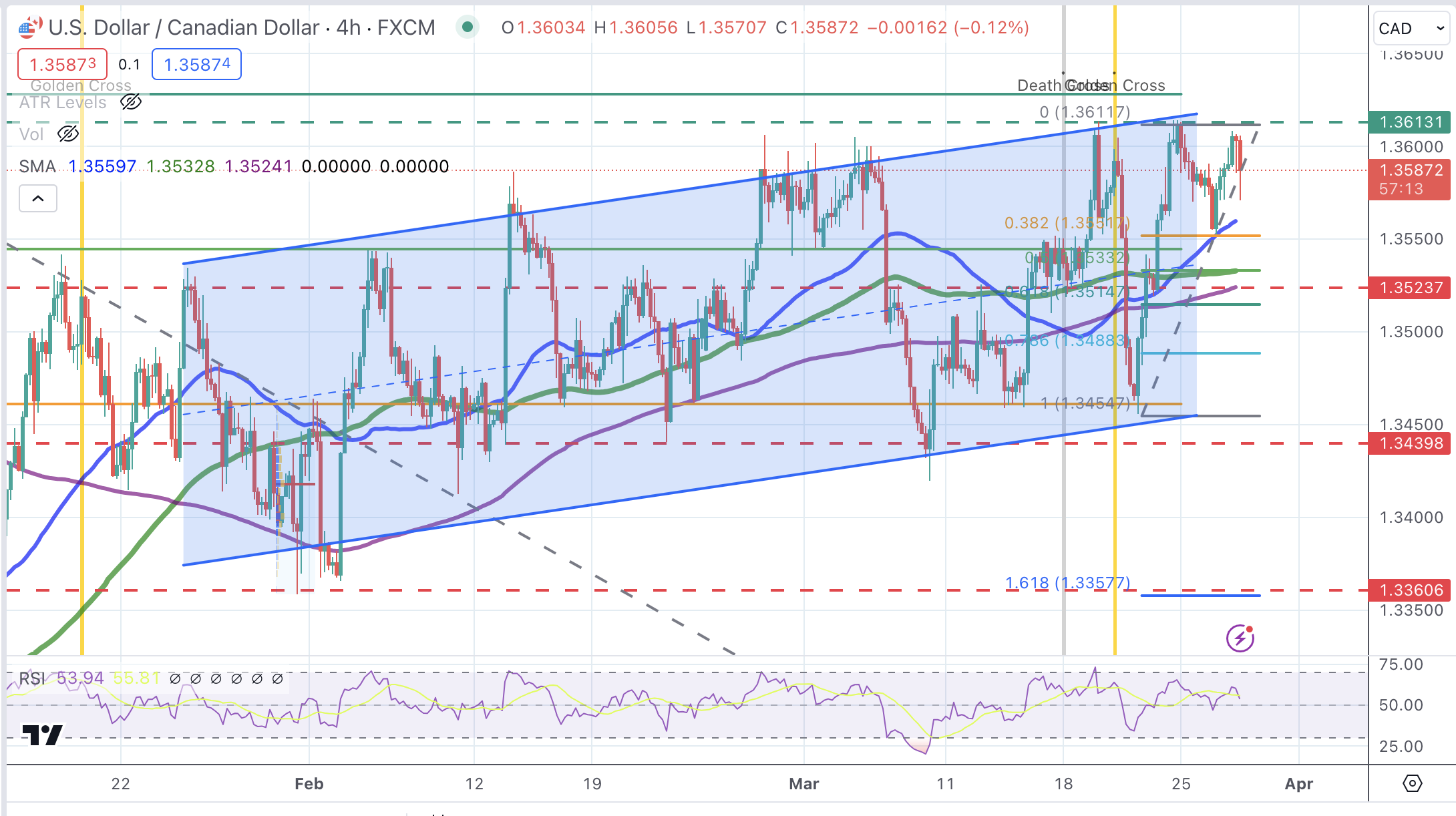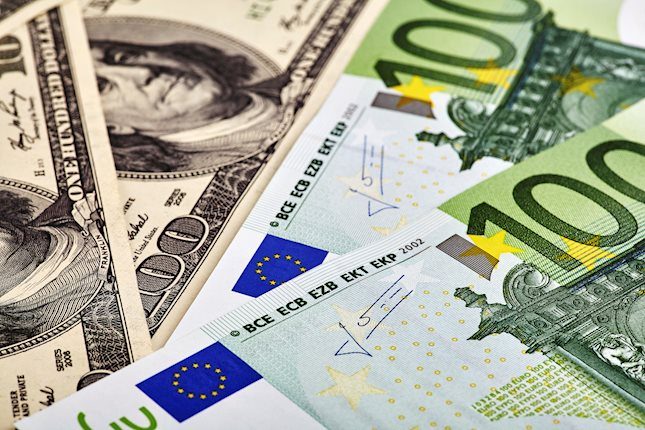- Canadian Dollar is practically flat on the daily chart with the USD ready near recent highs..
- BoC Rogers’ warnings about the country’s low productivity have weighed on the Loonie.
- The EIA has reported an unexpected increase on US Crude Oil stocks last week.
The Canadian Dollar (CAD) is trading back and forth, without a clear direction in Wednesday’s US trading session, with the US Dollar having the upper hand on thin trading ahead of the Easter Holiday.
The Loonie opened the day on its back foot, following comments from the Bank Of Canada’s Senior Deputy Governor, Carolyn Rogers, complaining about the low productivity and poor levels of investment. The CAD, however, managed to pare some losses later on although the unexpected increase in US Crude stockpiles reported by the Energy Information Agency has added weight to the commodity-linked CAD.
In the absence of first-tier macroeconomic releases today, the focus is on Fed Governor Christopher Waller, who is expected to speak about monetary policy at the Economic Club of New York later on Wednesday.
Daily digest market movers: The USD/CAD treads water with investors awaiting US PCE Inflation data
- The Canadian Dollar is moving sideways with the US Dollar nudging higher in a quiet trading session.
- EIA Crude Oil stocks increased by 3,165 million Barrels in the week of March 22 against market expectations of a decline of above 1,275 million Barrels.
- Bank of Canada Senior Deputy Governor Rogers has warned that low productivity is going to be a hindrance to economic growth.
- On Tuesday, US macroeconomic releases showed mixed figures, with Durable Goods Orders increasing beyond expectations while the Conference Board’s Consumer Confidence contracted unexpectedly.
- According to the CME Group FedWatch Tool, markets are pricing more than a 60% chance that the Federal Reserve will start cutting rates in June, which is keeping USD bulls in check.
- The highlight of the week will be the US PCE Prices Index, the Fed’s inflation gauge of choice, which is expected to have accelerated at a 2.5% yearly pace in February from 2.4% in the previous month.
- The core PCE Prices Index is expected to have risen at a 2.8% yearly pace and 0.4% on the monthly rate in February, from 2.8% and 0.3%, respectively, in January.
Canadian Dollar price today
The table below shows the percentage change of Canadian Dollar (CAD) against listed major currencies today. Canadian Dollar was the weakest against the Japanese Yen.
| USD | EUR | GBP | CAD | AUD | JPY | NZD | CHF | |
| USD | 0.12% | 0.01% | 0.04% | 0.22% | -0.09% | 0.16% | 0.24% | |
| EUR | -0.10% | -0.11% | -0.05% | 0.12% | -0.13% | 0.07% | 0.14% | |
| GBP | -0.01% | 0.10% | 0.03% | 0.21% | -0.02% | 0.15% | 0.22% | |
| CAD | -0.05% | 0.08% | -0.02% | 0.18% | -0.08% | 0.13% | 0.20% | |
| AUD | -0.22% | -0.10% | -0.21% | -0.19% | -0.32% | -0.05% | 0.01% | |
| JPY | 0.09% | 0.21% | 0.10% | 0.13% | 0.30% | 0.19% | 0.28% | |
| NZD | -0.15% | -0.04% | -0.19% | -0.12% | 0.06% | -0.22% | 0.08% | |
| CHF | -0.23% | -0.12% | -0.23% | -0.20% | -0.01% | -0.27% | -0.07% |
The heat map shows percentage changes of major currencies against each other. The base currency is picked from the left column, while the quote currency is picked from the top row. For example, if you pick the Euro from the left column and move along the horizontal line to the Japanese Yen, the percentage change displayed in the box will represent EUR (base)/JPY (quote).
USD/CAD 4-Hour Chart

All in all, the Canadian Dollar remains biased higher, but it seems to need an extra boost to break above recent highs. The US PCE Prices Index and Fed Powell’s comments are due on Good Friday, and the low trading volumes might boost the impact of these events.
Canadian Dollar FAQs
The key factors driving the Canadian Dollar (CAD) are the level of interest rates set by the Bank of Canada (BoC), the price of Oil, Canada’s largest export, the health of its economy, inflation and the Trade Balance, which is the difference between the value of Canada’s exports versus its imports. Other factors include market sentiment – whether investors are taking on more risky assets (risk-on) or seeking safe-havens (risk-off) – with risk-on being CAD-positive. As its largest trading partner, the health of the US economy is also a key factor influencing the Canadian Dollar.
The Bank of Canada (BoC) has a significant influence on the Canadian Dollar by setting the level of interest rates that banks can lend to one another. This influences the level of interest rates for everyone. The main goal of the BoC is to maintain inflation at 1-3% by adjusting interest rates up or down. Relatively higher interest rates tend to be positive for the CAD. The Bank of Canada can also use quantitative easing and tightening to influence credit conditions, with the former CAD-negative and the latter CAD-positive.
The price of Oil is a key factor impacting the value of the Canadian Dollar. Petroleum is Canada’s biggest export, so Oil price tends to have an immediate impact on the CAD value. Generally, if Oil price rises CAD also goes up, as aggregate demand for the currency increases. The opposite is the case if the price of Oil falls. Higher Oil prices also tend to result in a greater likelihood of a positive Trade Balance, which is also supportive of the CAD.
While inflation had always traditionally been thought of as a negative factor for a currency since it lowers the value of money, the opposite has actually been the case in modern times with the relaxation of cross-border capital controls. Higher inflation tends to lead central banks to put up interest rates which attracts more capital inflows from global investors seeking a lucrative place to keep their money. This increases demand for the local currency, which in Canada’s case is the Canadian Dollar.
Macroeconomic data releases gauge the health of the economy and can have an impact on the Canadian Dollar. Indicators such as GDP, Manufacturing and Services PMIs, employment, and consumer sentiment surveys can all influence the direction of the CAD. A strong economy is good for the Canadian Dollar. Not only does it attract more foreign investment but it may encourage the Bank of Canada to put up interest rates, leading to a stronger currency. If economic data is weak, however, the CAD is likely to fall.
Information on these pages contains forward-looking statements that involve risks and uncertainties. Markets and instruments profiled on this page are for informational purposes only and should not in any way come across as a recommendation to buy or sell in these assets. You should do your own thorough research before making any investment decisions. FXStreet does not in any way guarantee that this information is free from mistakes, errors, or material misstatements. It also does not guarantee that this information is of a timely nature. Investing in Open Markets involves a great deal of risk, including the loss of all or a portion of your investment, as well as emotional distress. All risks, losses and costs associated with investing, including total loss of principal, are your responsibility. The views and opinions expressed in this article are those of the authors and do not necessarily reflect the official policy or position of FXStreet nor its advertisers. The author will not be held responsible for information that is found at the end of links posted on this page.
If not otherwise explicitly mentioned in the body of the article, at the time of writing, the author has no position in any stock mentioned in this article and no business relationship with any company mentioned. The author has not received compensation for writing this article, other than from FXStreet.
FXStreet and the author do not provide personalized recommendations. The author makes no representations as to the accuracy, completeness, or suitability of this information. FXStreet and the author will not be liable for any errors, omissions or any losses, injuries or damages arising from this information and its display or use. Errors and omissions excepted.
The author and FXStreet are not registered investment advisors and nothing in this article is intended to be investment advice.
Recommended content
Editors’ Picks

GBP/USD: The bearish outlook remains in play below 1.2700
The GBP/USD pair edges lower to near 1.2675, the lowest level since August during the Asian trading hours on Friday. The cautious remarks from the Federal Reserve Chair Jerome Powell on Thursday and stronger US economic data boost the US Dollar broadly and weigh on the major pair.

EUR/USD rises to near 1.0550 after rebounding from yearly lows
EUR/USD breaks its five-day losing streak, trading around 1.0540 during the Asian session on Friday. This rebound is likely due to a downward correction in the US Dollar following comments from Fed Chair Jerome Powell.

Gold defends key $2,545 support; what’s next?
Gold price is looking to build on the previous rebound early Friday in search of a fresh impetus amid persistent US Dollar buying and mixed activity data from China.

Bitcoin to 100k or pullback to 78k?
Bitcoin and Ethereum showed a modest recovery on Friday following Thursday's downturn, yet momentum indicators suggest continuing the decline as signs of bull exhaustion emerge. Ripple is approaching a key resistance level, with a potential rejection likely leading to a decline ahead.

Trump vs CPI
US CPI for October was exactly in line with expectations. The headline rate of CPI rose to 2.6% YoY from 2.4% YoY in September. The core rate remained steady at 3.3%. The detail of the report shows that the shelter index rose by 0.4% on the month, which accounted for 50% of the increase in all items on a monthly basis.

Best Forex Brokers with Low Spreads
VERIFIED Low spreads are crucial for reducing trading costs. Explore top Forex brokers offering competitive spreads and high leverage. Compare options for EUR/USD, GBP/USD, USD/JPY, and Gold.